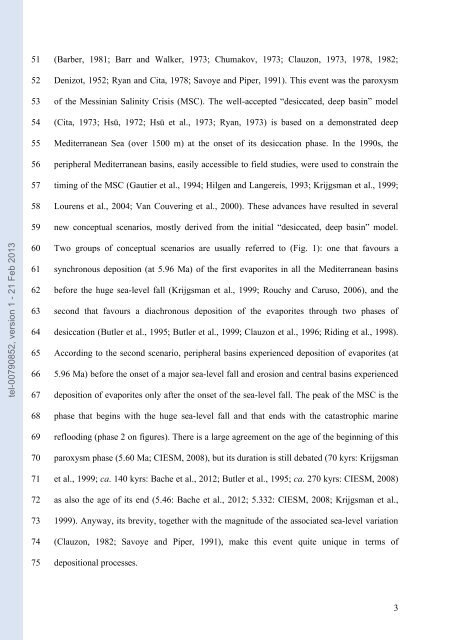Quantification des flux sédimentaires et de la subsidence du bassin ...
Quantification des flux sédimentaires et de la subsidence du bassin ...
Quantification des flux sédimentaires et de la subsidence du bassin ...
Create successful ePaper yourself
Turn your PDF publications into a flip-book with our unique Google optimized e-Paper software.
tel-00790852, version 1 - 21 Feb 2013<br />
51<br />
52<br />
53<br />
54<br />
55<br />
56<br />
57<br />
58<br />
59<br />
60<br />
61<br />
62<br />
63<br />
64<br />
65<br />
66<br />
67<br />
68<br />
69<br />
70<br />
71<br />
72<br />
73<br />
74<br />
75<br />
(Barber, 1981; Barr and Walker, 1973; Chumakov, 1973; C<strong>la</strong>uzon, 1973, 1978, 1982;<br />
Denizot, 1952; Ryan and Cita, 1978; Savoye and Piper, 1991). This event was the paroxysm<br />
of the Messinian Salinity Crisis (MSC). The well-accepted “<strong><strong>de</strong>s</strong>iccated, <strong>de</strong>ep basin” mo<strong>de</strong>l<br />
(Cita, 1973; Hsü, 1972; Hsü <strong>et</strong> al., 1973; Ryan, 1973) is based on a <strong>de</strong>monstrated <strong>de</strong>ep<br />
Mediterranean Sea (over 1500 m) at the ons<strong>et</strong> of its <strong><strong>de</strong>s</strong>iccation phase. In the 1990s, the<br />
peripheral Mediterranean basins, easily accessible to field studies, were used to constrain the<br />
timing of the MSC (Gautier <strong>et</strong> al., 1994; Hilgen and Langereis, 1993; Krijgsman <strong>et</strong> al., 1999;<br />
Lourens <strong>et</strong> al., 2004; Van Couvering <strong>et</strong> al., 2000). These advances have resulted in several<br />
new conceptual scenarios, mostly <strong>de</strong>rived from the initial “<strong><strong>de</strong>s</strong>iccated, <strong>de</strong>ep basin” mo<strong>de</strong>l.<br />
Two groups of conceptual scenarios are usually referred to (Fig. 1): one that favours a<br />
synchronous <strong>de</strong>position (at 5.96 Ma) of the first evaporites in all the Mediterranean basins<br />
before the huge sea-level fall (Krijgsman <strong>et</strong> al., 1999; Rouchy and Caruso, 2006), and the<br />
second that favours a diachronous <strong>de</strong>position of the evaporites through two phases of<br />
<strong><strong>de</strong>s</strong>iccation (Butler <strong>et</strong> al., 1995; Butler <strong>et</strong> al., 1999; C<strong>la</strong>uzon <strong>et</strong> al., 1996; Riding <strong>et</strong> al., 1998).<br />
According to the second scenario, peripheral basins experienced <strong>de</strong>position of evaporites (at<br />
5.96 Ma) before the ons<strong>et</strong> of a major sea-level fall and erosion and central basins experienced<br />
<strong>de</strong>position of evaporites only after the ons<strong>et</strong> of the sea-level fall. The peak of the MSC is the<br />
phase that begins with the huge sea-level fall and that ends with the catastrophic marine<br />
reflooding (phase 2 on figures). There is a <strong>la</strong>rge agreement on the age of the beginning of this<br />
paroxysm phase (5.60 Ma; CIESM, 2008), but its <strong>du</strong>ration is still <strong>de</strong>bated (70 kyrs: Krijgsman<br />
<strong>et</strong> al., 1999; ca. 140 kyrs: Bache <strong>et</strong> al., 2012; Butler <strong>et</strong> al., 1995; ca. 270 kyrs: CIESM, 2008)<br />
as also the age of its end (5.46: Bache <strong>et</strong> al., 2012; 5.332: CIESM, 2008; Krijgsman <strong>et</strong> al.,<br />
1999). Anyway, its brevity, tog<strong>et</strong>her with the magnitu<strong>de</strong> of the associated sea-level variation<br />
(C<strong>la</strong>uzon, 1982; Savoye and Piper, 1991), make this event quite unique in terms of<br />
<strong>de</strong>positional processes.<br />
3

















